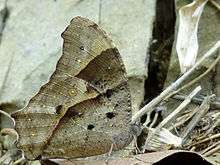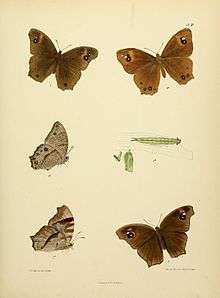Melanitis leda
| Common evening brown | |
|---|---|
 | |
| Wet-season form | |
 | |
| Dry-season form | |
| Scientific classification | |
| Kingdom: | Animalia |
| Phylum: | Arthropoda |
| Class: | Insecta |
| Order: | Lepidoptera |
| Family: | Nymphalidae |
| Genus: | Melanitis |
| Species: | M. leda |
| Binomial name | |
| Melanitis leda (Linnaeus, 1758) | |
| Synonyms | |
| |
Melanitis leda, the common evening brown, is a common species of butterfly found flying at dusk. The flight of this species is erratic. They are found in Africa, South Asia and South-east Asia extending to parts of Australia.
Description

Wet-season form: Forewing: apex subacute; termen slightly angulated just below apex, or straight. Upperside brown. Forewing with two large subapical black spots, each with a smaller spot outwardly of pure white inwardly bordered by a ferruginous interrupted lunule; costal margin narrowly pale. Hindwing with a dark, white-centred, fulvous-ringed ocellus subterminally in interspace two, and the apical ocellus, sometimes also others of the ocelli,on the underside, showing through.
Underside paler, densely covered with transverse dark brown striae; a discal curved dark brown narrow band on forewing; a post-discal similar oblique band, followed by a series of ocelli: four on the forewing, that in interspace 8 the largest; six on the hindwing, the apical and subtornal the largest.[1]
Dry-season form: Forewing: apex obtuse and more or less falcate; termen posterior to falcation straight or sinuous. Upperside: ground colour similar to that in the wet-season form, the markings, especially the ferruginous lunules inwardly bordering the black sub-apical spots on forewing, larger, more extended below and above the black costa. Hindwing: the ocellus in interspace 2 absent, posteriorly replaced by three or four minute white subterminal spots.
Underside varies in colour greatly. Antennae, head, thorax and abdomen in both seasonal forms brown or greyish brown: the antennae annulated with white, ochraceous at apex.[1]
Ecology
Colonel C. T. Bingham wrote of the genus in 1878:
The Melanitis was there among dead leaves, its wings folded and looking for all the world a dead, dry leaf itself. With regard to Melanitis, I have not seen it recorded anywhere that the species of this genus when disturbed fly a little way, drop suddenly into the undergrowth with closed wings, and invariably lie a little askew and slanting, which still more increases their likeness to a dead leaf casually fallen to the ground.
Resident butterflies are known to fight off visitors to the area during dusk hours.[2] This chase behaviour is elicited even by pebbles thrown nearby.[3]
The caterpillars feed on a wide variety of grasses including rice (Oryza sativa), bamboos, Andropogon, Rotboellia cochinchinensis,[4] Brachiaria mutica,[4] Cynodon, Imperata, and millets such as Oplismenus compositus,[5] Panicum and Eleusine indica.[6]
Adults feed mainly on nectar, and in rare cases visit rotting fruits.[7]
Image gallery
 Upperside pattern
Upperside pattern- Wet season
 Dry season
Dry season
References
- 1 2 Bingham, C.T. (1905). The Fauna of British India, Including Ceylon and Burma Butterflies. 1 (1st ed.). London: Taylor and Francis, Ltd.
- ↑ D. J. Kermp (2003). "Twilight fighting in the evening brown butterfly, Melanitis leda (L.) (Nymphalidae): residency and age effects". Behavioral Ecology and Sociobiology. 54 (1): 7–13. doi:10.1007/s00265-003-0602-7.
- ↑ D. J. Kemp (2002). "Visual mate searching behaviour in the evening brown butterfly, Melanitis leda (L.) (Lepidoptera: Nymphalidae)" (PDF). Australian Journal of Entomology. 41 (4): 300–305. doi:10.1046/j.1440-6055.2002.00311.x.
- 1 2 S. Kalesh & S. K. Prakash (2007). "Additions of the larval host plants of butterflies of the Western Ghats, Kerala, Southern India (Rhopalocera, Lepidoptera): Part 1". Journal of the Bombay Natural History Society. 104 (2): 235–238.
- ↑ Krushnamegh Kunte (2006). "Additions to known larval host plants of Indian butterflies" (PDF). Journal of the Bombay Natural History Society. 103 (1): 119–120.
- ↑ Gaden S. Robinson, Phillip R. Ackery, Ian J. Kitching, George W. Beccaloni & Luis M. Hernández (2007). "HOSTS - a Database of the World's Lepidopteran Hostplants". Retrieved September 27, 2010.
- ↑ K. C. Hamer, J. K. Hill, S. Benedick, N. Mustaffa, V. K. Chey & M. Maryati (2006). "Diversity and ecology of carrion- and fruit-feeding butterflies in Bornean rain forest". Journal of Tropical Ecology. 22 (1): 25–33. doi:10.1017/S0266467405002750.
| External identifiers for Melanitis leda | |
|---|---|
| Encyclopedia of Life | 140106 |
| NCBI | 127353 |
| Wikimedia Commons has media related to Melanitis leda. |